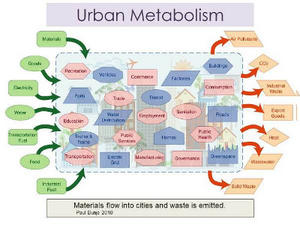InfrastructureImproving cities by using the notion of “urban metabolism”
As is the case with organisms, cities need energy, water, and nutrients, and they need to dispose of wastes and byproducts in ways which are viable and sustainable over the long run. This concept of “urban metabolism” is a model for looking systematically at the resources that flow into cities and the wastes and emissions that flow out from them in order better to understand the environmental impacts of cities and to highlight opportunities for efficiencies, improvements, and transformation.

Urban Metabolism flow chart // Source: ucla.edu
As is the case with organisms, cities need energy, water, and nutrients, and they need to dispose of wastes and byproducts in ways which are viable and sustainable over the long run. This notion of “urban metabolism” is a model for looking systematically at the resources that flow into cities and the wastes and emissions that flow out from them — to understand the environmental impacts of cities and to highlight opportunities for efficiencies, improvements, and transformation.
A Yale University release reports that Yale University’s Journal of Industrial Ecology has just published a special issue on Sustainable Urban Systems which focuses on the integration of engineered infrastructures, people, and natural systems in the pursuit of environmentally sustainable cities.
Already more than half the world’s people — and 80 percent of those in developed nations — live in urban areas, and reducing the environmental impact of these expanding cities is one of the greatest challenges facing society in the coming decades. At the same time, cities present crucial opportunities for the efficient use of resources and low impact ways of life.
“This is the urban century,” said Sir Peter Crane, dean of the Yale School of Forestry & Environmental Studies, “and the integrative perspective this issue provides is essential for the study of sustainable urban systems.”
This special issue examines topics such as the contribution of cities to global warming, opportunities for better management of waste electronics and storm water, and the use and fate of phosphorus — a resource that is both potentially scarce and polluting. The special issue presents research on eleven cities around the world including New York City, Delhi, Denver, Melbourne and London.
— Read more in Journal of Industrial Ecology 16, no. 6 (December 2012): 775–15, Special Issue: Sustainable Urban Systems
